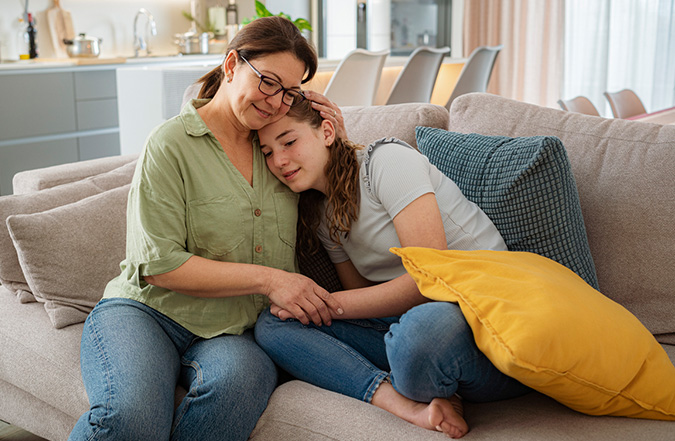
Nia Clark, MSW, is a child welfare consultant who has worked on behalf of system-involved youth and their families for nearly 16 years. As a Black transgender youth, Nia navigated the foster care system for 14 years. Robin P. McHaelen, MSW, is the founder and former executive director of True Colors, Inc., an advocacy group for LGBTQ+ youth. She has 30 years of experience working with LGBTQ+ youth in education, child welfare, and community settings.
This article is based on a webinar presented by Robin and Nia for All Children – All Families —a program that promotes inclusive and affirming LGBTQ+ practices in child welfare—as well as a follow-up interview with Nia. We thank Robin and Nia for granting us permission to share their insights.
According to some studies, including one in California, almost 1 in 3 youth in foster care identify as LGBTQ+. If you’re a foster or adoptive parent, you may know how important it is to create an affirming home, but you might have questions about where to start. This article will walk you through the steps you can take to affirm your child or youth and create a welcoming environment where they can thrive.
This is important work to do because, as a parent, you play a critical role in your child’s life. Backed by research from the Family Acceptance Project about the impact of families on child well-being, Robin explains, “The single most important factor is family acceptance.” So, let’s dive in.
Understand mental health risks for LGBTQ+ youth
According to a 2021 report by The Trevor Project that surveyed LGBTQ+ youth, 47% of Black youth seriously considered suicide in the past year. American Indian/Alaska Native youth were more likely to report a suicide attempt in the last year if they also experienced certain factors, such as foster care or food insecurity. Transgender and nonbinary youth had significantly higher risks of suicidality, as well as depression and anxiety.
“There is a mental health crisis all over the country for kids,” Robin says. And while all youth undergo stress when it comes to things like school and family, LGBTQ+ youth face additional forms of stress.
For example, when your child witnesses an act of violence and discrimination against other members of the LGBTQ+ community, this can be traumatizing. Your child may also experience rejection or abuse and may conceal their identity as a result. For additional information about the challenges LGBTQ+ youth face, the Children’s Bureau provides a fact sheet for foster parents, compiled by the Child Welfare Information Gateway.
Information about mental health risks for LGBTQ+ youth can feel overwhelming for parents, but there are effective ways to support your child.
Believe your child can have a happy future
“The best thing you can do is to believe that child can have a happy future as an adult,” Nia explains. She continues that when you believe your child will have a positive future, “You do everything within your love and your care to support the development of that young person as they transition to adulthood.” That belief will inform how you care for them.

Affirm your child for who they are
Gender affirmation means supporting the gender-diverse youth in your care for who they are. One way is to support how your child expresses their identity. For example, give your child compliments for things like their choice of nail polish and the type of clothing they wear.
Nia explains the importance of this firsthand as a previous youth in foster care. She navigated the system as a transgender youth and recalls one of her foster homes as being affirming. During a quarterly clothing check, adults supported Nia in figuring out how to dress. Reflecting on that time, she says, “It was really helpful to have adults in my life who supported that, and who also supported the moments when I wasn’t as confident.”
Gender affirmation means supporting the gender-diverse youth in your care for who they are.
Here are some other steps you can take to affirm your child:
- Use your child’s affirmed name and pronouns.
- Advocate within your community. You can push for change by having conversations at school board meetings, in town halls, and within your faith communities so that your child’s gender expression and identity are supported in these spaces.
- Make an ongoing commitment to sustaining an affirming home. As your child grows up and goes through adolescence, their needs will change.
Acknowledge the young people in your life with an LGBTQ+ affirmation calendar
June is National Pride Month, but adults have the opportunity to show up for the young people in their life all year long. All Children – All Families has put together an LGBTQ+ affirmation calendar that includes important days throughout the year, including Queer Youth of Faith Day and International Transgender Day of Visibility.
You can use this calendar to recognize the LGBTQ+ people in your life. You might even share it with friends and family who’d like to celebrate alongside you and your child!
Provide emotional permanency
When Nia navigated new foster homes as a youth, she describes feeling like she was on a TV show. The family was the main cast, and she was the guest star. She remembers thinking, “What do I have to do to become part of the main cast?”
When it comes to foster care and adoption, we strive to find permanency for every child. People often think of physical permanency. But emotional permanency is just as important. Does your child feel they belong and are part of the family?
With emotional permanency, your child knows they belong. They feel safe, secure, and included in your home. They are not worried about being kicked out or facing other consequences if they express their identity, and they don’t feel they need to be on their best behavior to stay in your home. They understand they are part of the “main cast.”
Finally, help your child develop positive coping skills
You won’t always be there to protect your child, but you can help them develop positive coping skills.
Positive coping skills build resiliency in your child and help them have a positive identity. To develop these skills, your child should have a community where they can feel like their best selves.
To do this, help your child access positive peer relationships. The goal is for your child to connect with others in the LGBTQ+ community and to prevent isolation.
- Point your child to resources like Gender Spectrum and PFLAG, where they can find peer support groups and resources. In fact, PFLAG has support groups for LGBTQ+ youth and their parents.
- Let your child know about resources like The Trevor Project and the Trans Lifeline. According to Nia, “They’re opportunities for a young person to speak to an [LGBTQ+] adult about some of the feelings that they’re going through.”
- Mentorship programs are another avenue for this. Consider connecting your child with mentors through LGBTQ+ mentorship programs.
You may already be taking the steps mentioned in this article, or you’re looking for a place to start. Wherever you are in this process, know that you are taking critical steps for your child’s well-being.
To foster and adoptive parents who are committed to creating a safe and affirming home for the youth in their care, Nia has a final message: “Thank you for being foster parents and adoptive parents, and for being the adult who responds [in ways that help children have more positive outcomes]. I encourage and praise you for having an affirming response to [LGBTQ+] children.”


